Thomas Lodge Murray-Prior and his siblings
Thomas B. and Lizzie M-P had four children.
1. Thomas (Tom) Lodge Murray-Prior (23 March 1912 - 26 October 2000) was the 6th consecutive Thomas Murray-Prior and the 2nd Thomas Lodge Murray-Prior. He was born in Brisbane. Tom lived at the only one of the family's family cattle properties left, Maroon, until he was 7 or 8 years old. The family then moved to Southport where he attended The Southport School. They later moved to the Blue Mountains town of Leura in NSW because it was thought the clean mountain air would be of benefit to his brother Hugh's poor health due to poliomyelitis affecting his leg. Tom L2 attended Leura State School then, when he was nearly 13 years old, The King’s School as a boarder during 1925-29 (at the original site of the school in Parramatta), leaving after he obtained his Leaving Certificate. His adventurousness as a young boy led to an amazing trip with a friend in a self-made canoe down the Nepean and Hawkesbury Rivers, then out to sea and into Sydney harbour: for more, click canoe!
Tom's school record reveals the talents which he also displayed in later life. In his leaving certificate, he gained an A in Physics and Bs in Maths 1 and 2, Mechanics and English. Maths remained a love for all his life. He played rugby union, cricket, was in the athletics team, and excelled in both boxing and rowing. One example of his sporting prowess was that in 1929 he rowed as bow in the 1st IV. In his final year of school, he was also a ‘house monitor’ (prefect) of School House, King's original boarding house. When he left King's, his record there was summarised with the comment, 'A boy of good character whom we can recommend'.1)
After leaving school, Tom tried his luck in far North Queensland. His ventures included tobacco farming near Dimbulah with his brother Standish (Narn); tin mining near Chillagoe; and contracting to build the Cooktown aerodrome. None apparently were very successful. He decided to try cane cutting at the Munro Estate cane farms at Pawngilly near Cairns. To travel to Pawngilly, he had to catch the small rail-motor train from Cairns down to the nearest railway station which was a very small station called Mirriwinni.
When Tom stepped onto the platform at Mirriwinni, the only other person there was ‘this very attractive young girl’. He asked her for directions to the Munro estate, but received a very cold stare and she immediately turned away from him. She was Lillian Newitt who had been taught ‘never to speak to strangers’. Another challenge for young Tom but, this time, his luck changed as several years later, on 17 January 1939, he and Lillian Myrtle Kathleen Newitt (16 June 1917-19 April 2002) married in her home town of Babinda.2) She was born in Childers, a sugar town south of Bundaberg, but her family had moved to Babinda to be near her mother's family, the Grummitts. Babinda was the nearest railway station to the north of Mirriwinni; Lillian had been at Mirriwinni because she had been visiting a friend on the day they met on that very tiny railway station. Fate!
Tom was lucky to have meet Lillian on that small, isolated railway station. She was beautiful with a quick sense of humour and a very engaging, warm personality. Her private grief was her difficulty carrying a pregnancy to full term. Five days after the outbreak of World War II, on 6 September 1939, her first son was born prematurely. The couple were living in Upper Barron where Tom was a road contractor.3) Their baby only lived a day, and was named Ian.4) The next year they were luckier, and had another boy, called Thomas, to continue the family naming tradition.
On 5 January 1941, Tom joined the Royal Australian Air Force (RAAF) 60 Squadron. Given his talent for mathematics, it was fitting that he became a navigator. He, Lillian and their baby went to Cootamundra for his training. The family story is that their baby learnt to crawl along the bar of the Cootamundra pub! When Tom completed his training and was posted overseas, Lillian and her son lived with Tom's parents, Thomas Bertram and Lizzie M-P and sister Vi at their home 'Birrilli' in Leura. They lived there for the duration of the war.5) There are numerous photos of Lillian and her son at Birrilli during this time as Lizzie M-P was a keen photographer and Lillian sent the photos to Tom with loving messages written on the back. When he eventually returned to Australia, the photos came back too. Tom in RAAF photos
Photo [scan again] of Thomas L. and Lillian M-P with their eldest son - called Thomas of course! 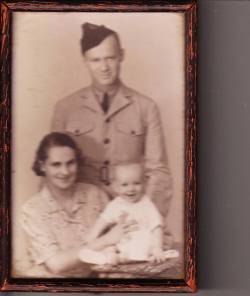 6)
6)
Tom had an adventurous war, serving for a time in the South African air force, in the UK, in Europe, in India (Bombay), USA (San Francisco), Dalby, Queensland and Darwin. For a listing of his activities, click on Air Force Experiences7) Like his mother,Tom L2 was a keen photographer, and took photos whenever he could, especially in exotic locations like Egypt, and when involved in notable events like a visit from French resistance leader, Charles de Gaulle. He rose to become Flight Lieutenant and in 1943 was awarded the DFC (Distinguished Flying Cross). For a full list of his medals, click on Medals8) His citation for his DFC explained that he received it because he had 'taken part in many operational missions, the majority of which have been long distance flights over enemy territory and many under difficult and dangerous conditions.' The citation added that his work was 'consistently of a high order' and that he 'always set a fine example' to others.9) For three of his stories about the war, as told to his son, click on war stories
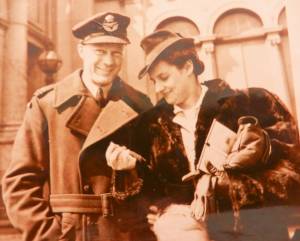 Thomas and Lillian after his award of the DFC.
Thomas and Lillian after his award of the DFC.
On 15 January 1946, Tom was formally discharged from the RAAF 12 Squadron after 5 years of active war service. Then followed difficult times, just like many long-time war veterans adjusting to ‘normal’ life. Tom went cane-cutting for a season, presumably in North Queensland.10) It did not help that his elder son had to adjust to having a father present, and that another son had been born in June 1945. The difficulties for all were compounded with the breakup of Tom's parents' marriage, resulting in the sale of the family home 'Birrilli’ at Leura. To add to the problems, his father had moved to Adelaide and died eight months after Tom's discharge.
Tom and his family, including his mother Lizzie (Dickie) and sister Vi M-P, made their new home in Southport, Queensland. Lizzie had purchased a 2-story house on a very large block of land in Bauer Street, close to where she used to live and not far from the The Southport School which Tom had attended. Tom drove his mother and possibly Vi from Leura up the Pacific Highway to Southport. It was a long and slow journey for, not only were there very few bridges for crossing the many rivers (this was done mainly by punts) and creeks, but the highway consisted of many winding, unsealed dirt roads once you left Sydney. Spare petrol jerrycans were essential and mechanical breakdowns on the rough roads were quite common. As a result, they occasionally had to camp near the highway on their long journey rather than at the planned towns. Lillian and the boys followed by train.
In Southport, Tom, Lillian and their sons lived with his mother until he bought a large newsagency in which both he and Lillian worked. The newsagency had a residence on top and was next to the Southport railway station. This busy station was not only the final destination for passengers but also for sheep and cattle who were offloaded into holding yards before their visit to the local abattoir. The only toilet or ‘dunny’ in the building was out the back near a small chook pen. Upstairs had 2 bedrooms, kitchen, lounge and a verandah which overlooked the railway station, Scarborough Street and the cattle/sheep holding yards. During their final year there, their home was even more cramped as Lillian’s ailing mother, Anne Newitt, lived with them. After Tom's mother died at Southport from cancer in 1949, he sold the business. In c.1950-51, he, Lillian and their two sons moved to Bundaberg, Queensland11) Vi remained in Southport and bought a very large house in Muir Street, on top of a hill with great views.
In Bundaberg, Tom bought the ‘China Arcade’ from relatives of his wife. He soon expanded the business, from not only selling top quality chinaware but also jewelry, clocks and watches, both new and needing repair. He moved the business to a larger and more strategically placed shop in the middle of Bourbong Street, Bundaberg's main shopping centre. Both were very well known and liked in the town and had an active social life: Lillian enjoyed meeting people and was respected as a good housewife who kept her home spotless. Tom especially bonded with those who shared his great love of golf. He would work in the shop five and a half days a week and on Saturday would religiously leave in time to play golf at the 18-hole course at the Bundaberg Golf Club. He was a good golfer. He also played on Sundays, when possible. In those days, enjoying the full benefits of the 19th hole every Saturday and/or Sunday was very common. With no way to measure breath alcohol, there were no laws about its strength. If you did imbibe too much on the occasional Saturday and arrived home a little late but very happy, the chances of losing your driving license was very slim. Why? Because, then, in a relatively small town if you were unlucky enough to be pulled over by a policeman that you didn’t know, you had to pass a driving sobriety test. This consisted of (a) being able to touch your nose with the forefinger of your right or left hand and/or (b) after the policeman had chalk drawn a straight line in the road or with a stick in the dirt, you then had to be able to walk in a relatively straight line. How Tom managed to drive home on a few occasions was interesting. A very good navigator indeed!
While Tom and Lillian enjoyed life in Bundaberg, they also experienced 2 disastrous life events: 1) In 1952, after having settled into their new home in Churchill Street, West Bundaberg, Lillian again gave birth prematurely. Their baby Anne died in Bundaberg's Lady Chelmsford Hospital on 30 July, having lived for not quite two days.12) It was a devastating blow as Tom and Lillian were so looking forward to their first daughter; and 2) One night in 1957, a fire destroyed everything in the China Arcade. Even worse was that they had forgotten to renew the business insurance some 1 or 2 weeks earlier. No payout! Electrical faults commonly started fires at the time.
Soon after the fire, the family, except for young Tom A. who was at boarding school in Brisbane, moved to Cairns. They rented a 3-bedroom house in Sheridan Street for 3 years. They then purchased a 3-bed, 2-level house in Hillview Crescent in the relatively new Cairns suburb of Edge Hill. In Cairns, Tom used his China Arcade experience from the financially rewarding lay-bys. He started a new high risk/ high return finance business, Country Cash Orders (CCO) by lending money, with appropriate interest, to customers. He issued a ‘Cash Order’ for the amount borrowed. Customers would then use the ‘cash order’ to buy goods (often things like a fridge) at selected Cairns stores. The office was in Alpine Street in the Cairns CBD. Several family members contributed to the operations with loans. Tom sold the profitable business sometime around 1967 to “Barter Credit Card” because he could see how the arrival of credit cards would soon make his business redundant. Lillian also worked to recoup the family finances, both by working in a bakery for many years and by managing a tight family budget. Some time after son Richard left home, Tom and Lillian sold their home in Edge Hill and downsized to a smaller semi-detached house in Holloways Beach, Cairns. During their time in Cairns, both were active in the RSL. Lillian received numerous awards for her work and was known as a big-hearted woman always willing to help those less fortunate.
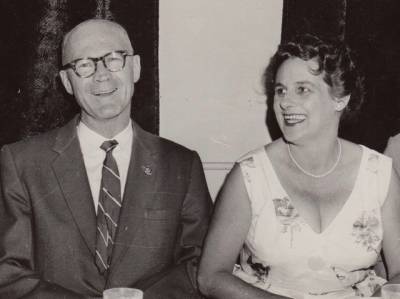 Photo: Tom and Lillian, 15 September 1960, at a dinner to commemorate the Battle of Britain.13)
Photo: Tom and Lillian, 15 September 1960, at a dinner to commemorate the Battle of Britain.13)
Around 1975, they moved from Cairns and bought a house on the beach at Bogangar, Tweed Heads in Northern NSW. There they made new friends and hosted family Christmas lunches in their garage, surrounded by the garden Lillian lovingly created despite the sandy soil. In the early 1990s, they moved to a demountable home in Darlington Park, Arrawarra, just north of Coffs Harbour. Once again, their home was on the beach but, this time, it also had its own 9-hole golf course where Tom proudly managed a hole in one: heaven for him! They also used this secure complex setting as a safe base to travel extensively in their caravan around Australia for many years. Whilst travelling, they picked fruit in many far-flung places. Finally, when in their 80s, they took a 3-week packaged trip through Asia. It was Lillian's first overseas trip and a big eye opener for her. After Lillian had a severe illness in December 1999, Tom became her carer and looked after her very well.
Tom was softly spoken and a very fit man who, for example, if ever he felt a little ‘off colour’, would go for a run or a long walk. He always felt better after. His long battle with myeloid leukaemia finally caught up with him during a visit he and Lillian made to son Richard and family in Townsville. He died in the old Townsville hospital on 26 October 2000, surrounded by his immediate family. He and Lillian had been married for 63 years. His funeral in Townsville was followed by a wake to remember, attended by all his immediate family. His ashes were part placed around a special tree on the Darlington Park golf course and later the remainder was placed in the M-P family grave at the Toowong Cemetery in Brisbane with many of his forebears. Lillian died, with her family by her side, in April 2002 in Coff Harbour Hospital, 18 months after her husband and 5 months after her youngest son Richard. Her ashes lie next to her husband in the M-P family grave site.
Two of Thomas and Lillian's four children survived infancy: for details see the next generation. For more photos, click on Thomas & Lillian
2. Minnie Violet (Vi) M-P (26 June 191314) - 27 June 199215). She was known to her immediate family as Vi and to the rest of the family as Aunt Vi. She was born at Highlands, the home of her grandparents in Sandgate Road, Albion (an inner suburb of Brisbane).
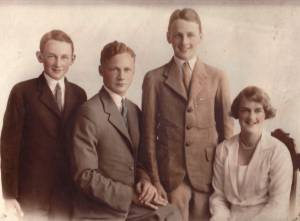 Siblings Hugh, Thomas L., Standish and Violet M-P: all served during World War II.16)
Siblings Hugh, Thomas L., Standish and Violet M-P: all served during World War II.16)
The three younger siblings Stan, Vi and Hugh, probably at Maroon.17):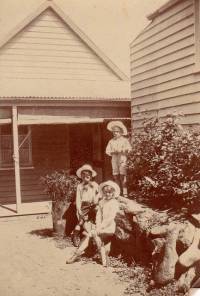
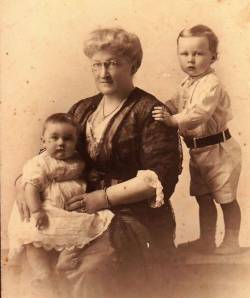 Minnie Lightoller with her grandchildren Vi and Thomas M-P, c.1914.18)
Minnie Lightoller with her grandchildren Vi and Thomas M-P, c.1914.18)
Vi's early life was similar to that of her brothers. She lived on the family’s last remaining cattle property, Maroon, until she was 6 or 7. After they left Maroon, the family lived for a short time in Southport, then moved out of Queensland to Thomas Bertram and Lizzie M-P's home Birrilli, at Leura in the Blue Mountains of NSW. During 1927-30, from the age of 13 and by now living in Leura, Vi was a boarder at the MLC School in Burwood, Sydney. She was captain of the school’s 2nd B Tennis team. Tennis was also very much a part of the social life at Birrilli, which had its own tennis court. In Vi's school holidays, tennis parties at home were very common with her brothers who, being boarders at The King’s School in Sydney, would bring home friends for holidays and occasional weekends. Of all the sports that she played, tennis was the one sport that she enjoyed and played all her life.
Vi shared the M-P love of horses, owing many in her lifetime. She thoroughly enjoyed horse riding for a large part of her life. As she had grown up riding horses at a very young age at Maroon, she was an excellent rider. Vi was a keen sportswoman up until the last few years of her life, also enjoying golf, surfing, gardening and fishing.
Vi’s very social life at ‘Birrilli’, plus frequent Sydney trips to visit friends, changed with the outbreak of World War II in 1939. In 1941, her brother Tom, his wife Lillian and their baby, moved to live with Vi and her parents for the duration of the war. In 1942, Vi joined the Australian Women's Land Army. 19) 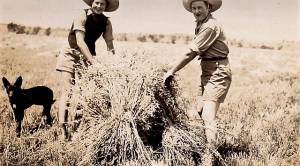
Vi (right) with a friend when working for the Australian Women's Land Army, 1943.
After the War ended, around late 1946/1947 when her parents separated and “Birrilli“ was sold, Vi, her mother and brother Tom, returned to Southport. After her mother died there in 1949, Vi very astutely used her inheritance to buy shares and a very large, traditional Queensland home (high on stilts, to catch the breeze). It was on two very large blocks of land on top of a hill in Muir Street. This house had magnificent views out to sea and, most importantly, had very high ceilings which allowed the display of many family inherited paintings, swords, furniture etc. which her brother Tom had asked Vi to look after, plus her own inheritances. Muir St. became the base of Vi’s active involvement and support of her two brothers who had children. Whenever they asked for help, for example due to sickness, Vi would drop everything to go and assist.
Muir St became the holiday destination for her brother Tom's children when they were growing up. Mary and John McClymont spent many holidays there as well. They were the children of Minnie McClymont (Aunt Min), who was Vi’s widowed cousin on her mother’s side and very dear friend. The McClymonts lived in the Brisbane suburb of Toowong. While they were all in junior school, these four children spent many wonderful holidays together at Currigee on South Stradbroke Island along with Vi and Minnie McClymont in a very small fibro hut, The Peanut. Minnie’s father had, in earlier times, built, owned and occasionally stayed at there because he held many oyster leases in this then-remote area. The Peanut was aptly named as it contained two rooms, small front and rear verandahs, a wood stove, kerosene lamps (no electricity), a table and chairs, beds, a water tank (no running water) and an outside dunny. While fishing with the extended family on these holidays, Vi was a very patient and understanding expert/martyr in untangling hand-held fishing lines for the young people. Great times and experiences were had by all - though one time the adults' experience was memorable but not so wonderful - click on whiskey. Vi's eldest nephew Tom, in senior school, boarded in Toowong, Brisbane, and Vi would drive up from Southport in her small VW to attend many of his boarding school events, especially the sporting events. She became Aunt Vi to several of the other students.
Vi sold her Southport house in the late 1960s, and moved to Graceville in Brisbane, close to her nephew Tom’s family in the nearby suburb of Corinda. Vi was a great help to the family and, on the weekly car trip to the local shop for ice-creams, the four young children would eat them sitting on the back seat or standing in the small area behind the back seat (no seat belts then). When they had finished their ice-creams, Aunt Vi would apparently (so their parents belated learned) let some of the children ride on the running boards of her then slow-moving, small VW beetle around the large grassed grounds and paddocks around their home. Ice cream excursions were exciting!
At various times, family members resided with Vi at Graceville. Julie Gillman (neé M-P) stayed with her while she undertook tertiary studies. John McClymont stayed with her after the Vietnam War as his mother, Minnie, had died while he was in Vietnam.
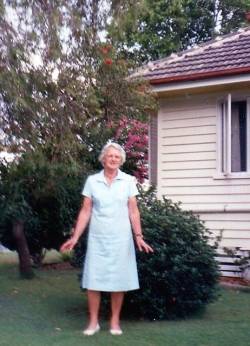 Vi outside her home Graceville.20)
Vi outside her home Graceville.20)
Vi’s other interests include the various dogs she owned in her life. Her South Stradbroke Island experience didn't stop her habit of enjoying a good whisky and a plain Capstan cigarette every night before dinner. These activities were a then common M-P family, before-dinner trait.
Vi never married. She had serious romances and thoughts of marriage, but the stumbling block was religion. At the time, it was difficult for practising Protestants to marry practising Catholics, and vice versa - and especially hard to resolve the issue in which faith any children would be raised. Religious bigotry (by modern standards) or religious conventions (by past standards) meant that it was instilled in family members that no Murray-Prior, of the Church of England faith, could marry a Roman Catholic. It was a very strong and long-held view, probably reinforced by the family's Irish roots. As in many families on both sides of the religious divide, there was also the threat of disinheritance and ostracism. Vi had several very serious romances, but the men were all Catholics. Such were the times.
By May 1992, Vi had suffered several small strokes (TIAs) in her home at Graceville. Consequently, she was moved to Coffs Harbour where she lived with and was cared for by her eldest nephew Tom and his wife Theresa M-P. Vi, aged 79, suffered a massive stroke and died very soon after, on 27 June 1992 in the Coffs Harbour Base Hospital. Her extended family held a wake and service in Coffs, then a memorial service at the Church of England in Graceville. Her ashes were distributed by her immediate family at Maroon, the cattle property near Beaudesert in Queensland where she had spent the first years of her life. Vi was a person of strong character and values. She could be very blunt and would forcibly tell anybody in the family if she thought they had deviated from her values. Equally, she was very caring and thoughtful with a delightful sense of humour and often a ‘twinkle’ in her eyes. Her deep love for her family, in later life especially her nephews and nieces, was reciprocated. As her nephew says, you need someone like Vi in every family.
For more photos of Vi, click on Vi Photos
3. Standish (Stan) Haly M-P (13 February 1915-1 August 1994) was born in Brisbane. Stan, or Narn as he was known by the family, attended school at Southport then, when family moved to NSW, Leura Public School. He attended The Kings School at Parramatta from 1926-33. At Kings he was a keen sportsman, representing the school in athletics, rugby and rowing.21) After leaving school it is thought that he moved to north Queensland where he was involved in tobacco farming with his brother Tom west of Dimbulah and in sugar cane work for the Munro Estate at Pawngilly, south of Cairns.
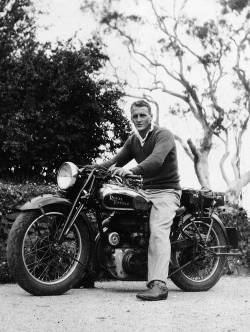 Stan on his motorbike, probably before the War.
Stan on his motorbike, probably before the War.
When World War II broke out, he attempted to join the Royal Australian Air Force but was rejected due to colour blindness. On 8 May 1940 he enlisted in the 2/1st Australian Anti-Aircraft Regiment. On enlisting he gave his occupation as 'sugar cane student' and that he had military experience with the Kings School cadets.22) Stan's unit embarked on the Orcades from Port Tewfik, Egypt as part of the force code named as 'Stepsister', which was the subject of heated arguments between Churchill and Curtin about the deployment of Australian forces returning from the Middle East.23) Eventually Curtin won the argument and the Orcades was tasked to offload troops to defend Indonesia. The Orcades was off the southern tip of Sumatra on Friday 13 February 1942 (Stan's 27th birthday) without sighting or being attacked by Japanese planes. On the 15th, units including two troops of the 2/1st Light AA, one of which was Stan’s, were disembarked via a small coastal vessel and landed at Telukbetung (now called Bandar Lampung) in southern Sumatra. They were tasked to defend the airfield at Palembang (some 500 km by rail) north of the port. Fortunately they were notified that evening that the airfield had already been captured and were extremely lucky to be able to reboard the Orcades (which had seen their Aldis lamp signals and so had not left) on the morning of the 16th. They reached Batavia (now Jakarta) on 17th, where units began disembarking for the defence of Java. Once again, luckily for Stan's regiment, as they began disembarking on the 19th, they were notified to stay aboard; they later learned that Darwin had been bombed that day and their unit was needed to provide air defence for Darwin.To avoid Japanese submarines, the Orcades took Stan and his unit down the Western Australian coast and across the Great Australian Bight; they disembarked in Adelaide. After time at Darwin and the Atherton Tablelands, his unit was involved in the invasion of Borneo, landing at Balikpapan in what is now East (Kalimantan). At that time, Stan held the rank of Warrant Officer (Class 2). He was demobilised on 14 January 1946.
Stan returned to far north Queensland, where he bought a corner store in Bunda Street, Cairns. A Christmas card from him to his Aunt Gracie in 1947 has his address as 153 Bunda Street, Cairns.24) His children recall him talking about the people coming in to buy their packet of Bex every day: [addiction to this medicine caused kidney failure], that was why he would never allow 'headache' powders in the house. Facing competition from Coles and disillusioned by dishonest customers, he sold the shop and, it is thought, moved to Munro Estate to work with Richard Percival (Percy) Rudkin (a former Sergeant in the 5th Light Horse), who introduced him to his niece, Betty Rudkin. Betty's father was Thomas Sidney (Sid) Rudkin, 3rd Battalion, 1st AIF and later manager of Nyngan and Temora Agricultural Farms for the NSW Department of Agriculture. It appears that Betty's father, Sid, may have met Stan's father, Thomas Bertram M-P, as Betty remembers her father telling the family he met a man with one eye who was riding a horse, while they were holidaying in Leura. Stan purchased a cane farm on the north-eastern bank of the Josephine Creek bridge, Pawngilly (near Innisfail). He and Betty were married in a small ceremony at St Albans Anglican Church, Innisfail on 1 December 1951. Later they purchased another farm, diagonally across, on the south-western bank of the Josephine. They sold the farms in 1973 and moved to Pin Gin Hill outside of Innisfail, where Stan had various jobs until he died in a level crossing smash with a cane train outside of Innisfail on the 1 August 1994. Betty later moved to Cairns, staying at Heritage Gardens Retirement Village in Earlville, Cairns before moving to Farnorah Residential Aged Care, Cairns. She died on 28 May 2017 in Cairns Hospital following an operation to mend a fractured femur. Stan was an active member of the local Babinda and Bartle Frere community. He was a foundation member of the Babinda RSL, the Babinda Memorial Hall Committee and the Babinda Show Association, all of which involved active participation of RSL members. He held various executive roles in all these and was also an active member of Legacy.
Stan and Betty had a son and daughter both of whom married; the latter has three children. His daughter-in-law’s parents had experience in war that echoed much of Stan’s. William (Bill) O'Connor enlisted in the 2/2 Heavy Anti-Aircraft Regiment and Ellen O’Connor (nee Woods) in the 2/2nd Australian General Hospital, with both serving in the Middle East. In a twist of fate, Ellen was also in the 'Stepsister' force, travelling back from the Middle East. Her unit was offloaded in Java, only to be re-embarked and returned to Australia because their transport ship (to move the hospital) had been captured.
For more photos of Stan and his family, click on Stan.
4. Hugh Burnett M-P, born 22 July 1916 at Boonah, Queensland; died 15 November 1984.25) He contacted polio when young which affected a leg. His eulogy suggested that the family were advised to move from Queensland to a cooler climate, i.e. Leura.26) Like his brother, he went to King's School, leaving in 1935.27) As with all his siblings, and despite his polio legacy, Hugh was a capable sportsman.28) In adult life, he was a very good golfer and is remembered as having owned a racehorse.29) Hugh was a very social man, and a photograph in the Sydney Morning Herald shows him enjoying the opening night of one of Sydney's leading restaurants, Princes. He was shown with a future Prime Minister Gough Whitlam, a friend from university, and famed American violinist Guila Bustabo.30)
Hugh graduated from the University of Sydney with a Bachelor of Medicine, Bachelor of Surgery in 1942, in the midst of World War II. While at Sydney University, he lived at St Paul's College.31) He enlisted as a medical officer in the army on 15 July 1943, serving until 29 July 1947 apparently mainly in Papua new Guinea.32) After the War, he became a well-respected obstetrician/gynaecologist, from 1947 mainly working and living in Newcastle. He formed a partnership with Dr W. McLaughlin from 1948. He died aged 68 having suffered from serious illness for 'several years', including 'severe chest disease'.33)
On 5 October 1962, at the Kings School chapel, he married nurse Elizabeth Ann Harper (23 September 1935 - 5 March 2014)34); they had no children.35) After Hugh died, Elizabeth remarried, to Peter Clark. Again, there were no children of the marriage. She died in March 2014.36)
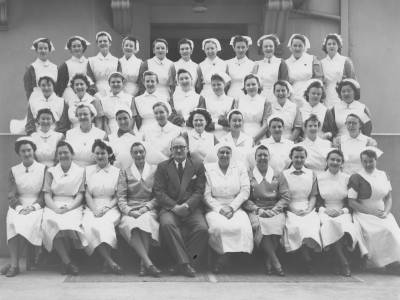 Dr Hugh M-P in 1952 when he was Medical Superintendent of Crown Street Women's Hospital.37) He is sitting next the legendary Matron Edna Shaw (in white) and with future Matrons Blair (right) and Love (left) as well as graduating midwives.38)
Dr Hugh M-P in 1952 when he was Medical Superintendent of Crown Street Women's Hospital.37) He is sitting next the legendary Matron Edna Shaw (in white) and with future Matrons Blair (right) and Love (left) as well as graduating midwives.38)
For more photos of Hugh M-P, click on Dr Hugh